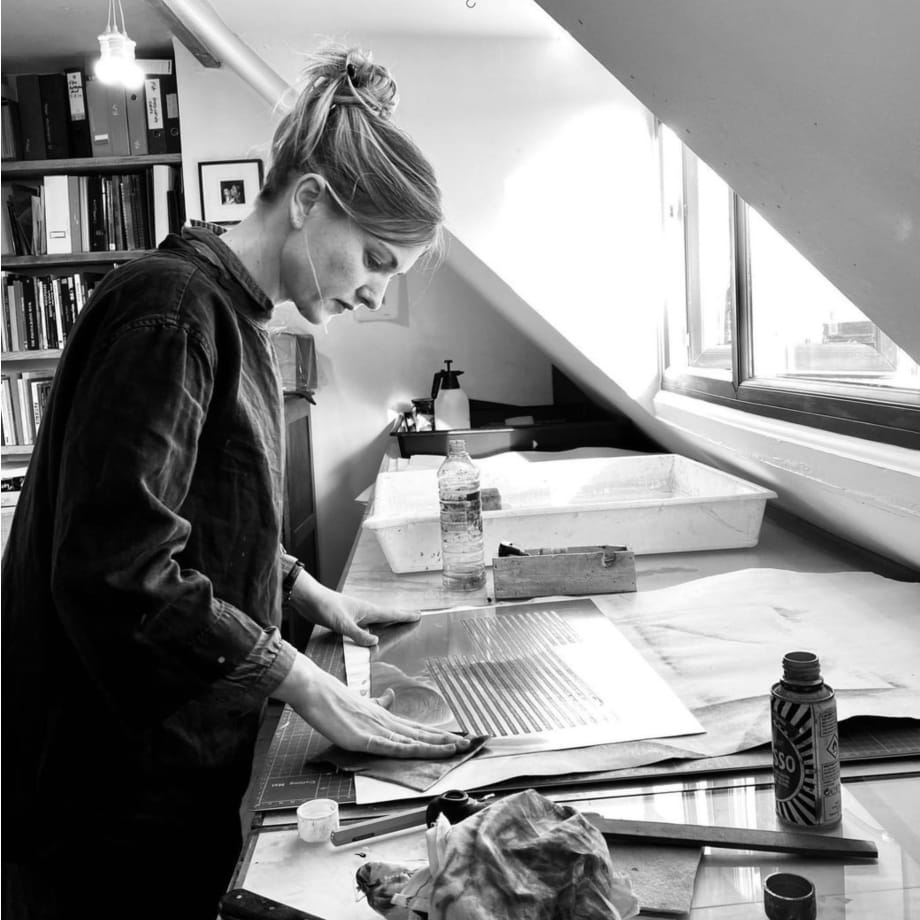What fascinates me about Gillian's work is the emphasis on paring down and taking away. She is heavily influenced by the Japanese aesthetic, Wabi-Sabi, the idea that there is serenity in the simple, the imperfect and the impermanent.
WHEN DID YOU REALISE THAT YOU WANTED TO BECOME AN ARTIST, AND WHY DID YOU CHOOSE PRINTMAKING, ETCHING IN PARTICULAR? DO YOU COME FROM A CREATIVE BACKGROUND?
I grew up in a family of designers, craftsmen, and artists, and making things was all I was interested in. As a result, I’m drawn to the sensitivity and physicality of etching. The pace is slow, and there is an indirectness that allows for serendipitous moments. I want the process to surprise me.
WHERE AND WHEN DID YOU STUDY AT ART SCHOOL? WHAT WAS THE EXPERIENCE LIKE, AND WHAT DID YOU LEARN?
I studied Photography (BA) at Manchester MET in 2002, then Multidisciplinary Printmaking (MA) at Bristol UWE in 2013. During the second year of my BA, I went to Australia as an exchange student. The newfound light and space of the Australian landscape had a profound impact on my visual language. My work became more minimal as I responded to the emptiness around me, and I began to shoot solely in black and white film. My MA was the springboard to having a career in printmaking. It enabled me to focus my ideas and develop a methodology still present in my work. Thanks to an award from UWE, I studied etching at Crown Point Press in San Francisco. This experience undoubtedly consolidated my practice as an artist specialising in etching.
YOUR WORK HAS A VERY ORIENTAL FEEL. WHERE DOES THIS COME FROM, AND WHAT ARE YOU TRYING TO CONVEY?
Wabi-Sabi is a concept which particularly resonates with me. It offers a repose from the noise and fast-paced nature of contemporary life. Similarly, my work deals with notions of imperfection, simplicity and ephemerality.
YOUR IMAGERY SEEMS VERY MUCH ABOUT PARING DOWN AND TAKING AWAY, FOCUSING ON WHAT ISN’T THERE. WHAT ARE YOU TRYING TO ACHIEVE FOR A FINAL REPRESENTATION?
I’m interested in using space in relation to matter. For example, the black areas in my work can be heavy, and in contrast, the space around is light, yet it can be felt and experienced just as much.
YOU ALSO HAVE AN INTEREST IN PHOTOGRAPHY. DOES THIS INFLUENCE YOUR WORK?
As a photographer, I used analogue techniques to explore fortuitous effects created by old toy cameras, flawed lenses, and out-of-date film. Using these variables often created a quality of image that I could not predict or plan for. Similarly, etching provides a chance to relinquish a certain amount of control. Its indirect nature and chemistry allow for unknown outcomes to arise.
YOUR WORK IS MONOCHROME (MOSTLY). IS THERE A REASON FOR THE ABSENCE OF COLOUR?
For me, working monochromatically helps focus the mind. The velvety richness of the black ink draws you in, creating a contemplative energy. There is, however, a subtle use of colour present in my work that is just as important. Using lightweight Japanese papers, I introduce soft oat background colours not only to record the quietest of marks but also to counterbalance the sheer severity of black.
WHICH OTHER ARTISTS DO YOU ADMIRE AND WHY? DO ANY DIRECTLY INFLUENCE YOUR WORK?
Zarina Hashmi for the importance she placed on handmade paper and the sculptural quality of her prints. John Zurier for the contemplative space his paintings create, and Rebecca Salter, whose work conveys a quietness and muted palette that speaks to me. The photographs of Ellsworth Kelly, and specifically the way he translated them into his paintings, have been particularly influential to my practice.
DO YOU WORK ON MULTIPLE PRINTS AT THE SAME TIME?
I prefer working on a series at the same time so the studio conditions and the way that I treat the materials are consistent. I tend to conceive work in pairs.
IS IT IMPORTANT HOW THE VIEWER REACTS TO YOUR WORK?
I want the work to evoke a sense of stillness. To create a space to ponder, absorb and linger.
WHAT OTHER INTERESTS DO YOU HAVE?
I collect textiles and handmade papers. I make my own paper from off-cuts and reject prints, and I’ve started experimenting with natural dyeing.










